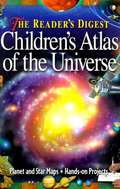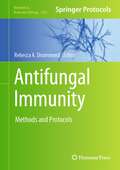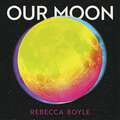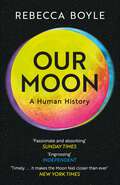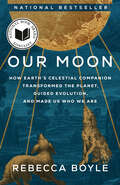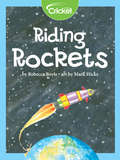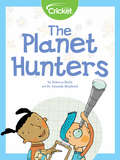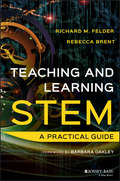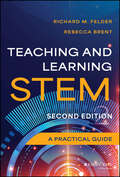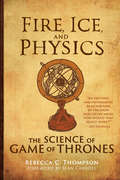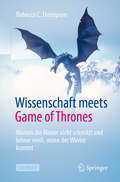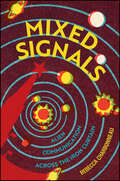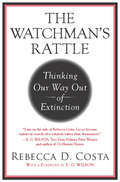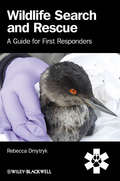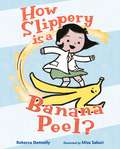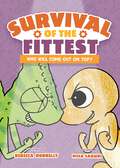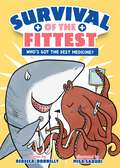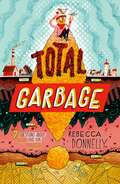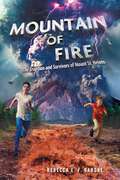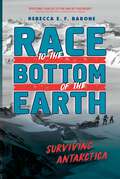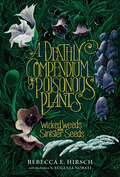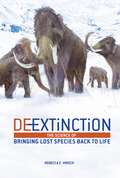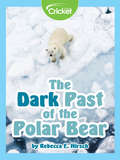- Table View
- List View
Children's Atlas of the Universe
by Reader'S DigestThe Reader's Digest Children's Atlas of the Universe will revolutionize the way kids learn about the stars. Combining spectacular color art (including maps of the planets) and hundreds of photographic images from space missions and telescopes, the atlas tells the story of the universe as it has never been told before. Every page is a storehouse of riveting, up-to-the minute information. Introductory sections cover Earth's place in space, the history of astronomy and space exploration, and modern observatories and space travel. The atlas then visits each of the planets of our solar system in turn, along with asteroids, comets, and meteors, before proceeding to the stars and galaxies of deep space. Included are detailed star charts for both Northern and Southern Hemisphere stargazers, a universe fact file, a glossary, and an index. Activities and projects provide a hands-on approach to understanding the principles of astronomy. The Reader's Digest Children's Atlas of the Universe continues the high standard in children's reference publishing established by The Reader's Digest Children's Atlas of the World. For children of all ages, this beautifully produced volume is the ultimate resource for learning about the mysteries of the universe.
Antifungal Immunity: Methods and Protocols (Methods in Molecular Biology #2667)
by Rebecca A. DrummondThis volume aims to help new investigators to the field by providing them with the protocols needed to set up clinically relevant animal models of fungal infection, as well as methods for in vivo immunology.Written in the format of the highly successful Methods in Molecular Biology series, each chapter includes an introduction to the topic, lists necessary materials and methods, includes tips on troubleshooting and known pitfalls, and step-by-step, readily reproducible protocols. Authoritative and cutting-edge, Antifungal Immunity: Methods and Protocols aims to be comprehensive guide for researchers in the field
Our Moon: A Human History
by Rebecca BoyleA cultural and scientific history of the Moon from prehistoric archaeology to the most recent technological and scientific research today.'A sweeping, lyrical new account of our cosmic neighbour'PETER BRANNEN, author of The Ends of the WorldEvery living being throughout history, across time and geography, has gazed up at the same moon.From the first prehistoric life that crawled onto land guided by the power of the tides, to the division of time into months and seasons for the first humans, the moon has driven the expansion and development of our world.It has inspired scientific discovery and culture from the ancient astronomers to the scientific revolution of Copernicus and Galileo, from the 1969 Apollo landings to writers and artists, and stirred an inexhaustible desire to know where we come from and how we got here.And as astronauts around the world prepare to return to the Moon - opening up new frontiers of discovery, profit and politics - Our Moon tells the dazzling story of how the Moon has shaped life as we know it, fuelled dramatic change across the globe and could be the key to humanity's future.(P)2024 Random House Audio
Our Moon: A Human History
by Rebecca BoyleLonglisted for the National Book Award 2024'Passionate and absorbing'SUNDAY TIMES'I learned more about the Moon by reading this book than after a lifetime of study'CHRIS HADFIELD, author of An Astronaut's Guide to Life on Earth'Superb: as much a feat of imagination as it is a work of globe-trotting scholarship'TELEGRAPH'Boyle's writing shines, shifting through time and space, science and sentiment; a luminous read'REBECCA WRAGG SYKES, author of Kindred'You will never look at the Moon the same way again . . . fascinating'NEW STATESMAN'A riveting feat of science writing'ED YONG, author of An Immense World'Engrossing'INDEPENDENTEvery living being throughout history, across time and geography, has gazed up at the same moon.From the first prehistoric life that crawled onto land guided by the power of the tides, to the division of time into months and seasons for the first humans, the moon has driven the expansion and development of our world.It has inspired scientific discovery and culture from the ancient astronomers to the scientific revolution of Copernicus and Galileo, from the 1969 Apollo landings to writers and artists, and stirred an inexhaustible desire to know where we come from and how we got here.And as astronauts around the world prepare to return to the Moon - opening up new frontiers of discovery, profit and politics - Our Moon tells the dazzling story of how the Moon has shaped life as we know it, fuelled dramatic change across the globe and could be the key to humanity's future.
Our Moon: How Earth's Celestial Companion Transformed the Planet, Guided Evolution, and Made Us Who We Are
by Rebecca BoyleNATIONAL BESTSELLER • &“A riveting feat of science writing that recasts that most familiar of celestial objects into something eerily extraordinary, pivotal to our history, and awesome in the original sense of the word.&”—Ed Yong, New York Times bestselling author of An Immense WorldA New York Times Book Review Editors&’ ChoiceMany of us know that the Moon pulls on our oceans, driving the tides, but did you know that it smells like gunpowder? Or that it was essential to the development of science and religion? Acclaimed journalist Rebecca Boyle takes readers on a dazzling tour to reveal the intimate role that our 4.51-billion-year-old companion has played in our biological and cultural evolution. Our Moon&’s gravity stabilized Earth&’s orbit—and its climate. It drew nutrients to the surface of the primordial ocean, where they fostered the evolution of complex life. The Moon continues to influence animal migration and reproduction, plants&’ movements, and, possibly, the flow of the very blood in our veins. While the Sun helped prehistoric hunters and gatherers mark daily time, early civilizations used the phases of the Moon to count months and years, allowing them to plan farther ahead. Mesopotamian priests recorded the Moon&’s position in order to make predictions, and, in the process, created the earliest known empirical, scientific observations. In Our Moon, Boyle introduces us to ancient astronomers and major figures of the scientific revolution, including Johannes Kepler and his influential lunar science fiction.Our relationship to the Moon changed when Apollo astronauts landed on it in 1969, and it&’s about to change again. As governments and billionaires aim to turn a profit from its resources, Rebecca Boyle shows us that the Moon belongs to everybody, and nobody at all.
Riding Rockets
by Rebecca BoyleWhat does it take to fuel a rocket to space? Rocket scientists use hydrogen and liquid oxygen, but could anti-matter engines and black-hole drives fuel our spacecraft of the future?
The Planet Hunters
by Rebecca BoyleOne way astronomers search for planets is by looking for the shadows they cast in front of stars.
Teaching and Learning STEM
by Rebecca Brent Richard M. FelderRethink traditional teaching methods to improve student learning and retention in STEM Educational research has repeatedly shown that compared to traditional teacher-centered instruction, certain learner-centered methods lead to improved learning outcomes, greater development of critical high-level skills, and increased retention in science, technology, engineering, and mathematics (STEM) disciplines. Teaching and Learning STEM presents a trove of practical research-based strategies for designing and teaching courses and assessing students' learning. The book draws on the authors' extensive backgrounds and decades of experience in STEM education and faculty development. Its engaging and well-illustrated descriptions will equip you to implement the strategies in your courses and to deal effectively with problems (including student resistance) that might occur in the implementation. The book will help you: Plan and conduct class sessions in which students are actively engaged, no matter how large the class is Make good use of technology in face-to-face, online, and hybrid courses and flipped classrooms Assess how well students are acquiring the knowledge, skills, and conceptual understanding the course is designed to teach Help students develop expert problem-solving skills and skills in communication, creative thinking, critical thinking, high-performance teamwork, and self-directed learning Meet the learning needs of STEM students with a broad diversity of attributes and backgrounds The strategies presented in Teaching and Learning STEM don't require revolutionary time-intensive changes in your teaching, but rather a gradual integration of traditional and new methods. The result will be continual improvement in your teaching and your students' learning.
Teaching and Learning STEM: A Practical Guide
by Rebecca Brent Richard M. FelderThe widely used STEM education book, updated Teaching and Learning STEM: A Practical Guide covers teaching and learning issues unique to teaching in the science, technology, engineering, and math (STEM) disciplines. Secondary and postsecondary instructors in STEM areas need to master specific skills, such as teaching problem-solving, which are not regularly addressed in other teaching and learning books. This book fills the gap, addressing, topics like learning objectives, course design, choosing a text, effective instruction, active learning, teaching with technology, and assessment—all from a STEM perspective. You’ll also gain the knowledge to implement learner-centered instruction, which has been shown to improve learning outcomes across disciplines. For this edition, chapters have been updated to reflect recent cognitive science and empirical educational research findings that inform STEM pedagogy. You’ll also find a new section on actively engaging students in synchronous and asynchronous online courses, and content has been substantially revised to reflect recent developments in instructional technology and online course development and delivery. Plan and deliver lessons that actively engage students—in person or online Assess students’ progress and help ensure retention of all concepts learned Help students develop skills in problem-solving, self-directed learning, critical thinking, teamwork, and communication Meet the learning needs of STEM students with diverse backgrounds and identitiesThe strategies presented in Teaching and Learning STEM don’t require revolutionary time-intensive changes in your teaching, but rather a gradual integration of traditional and new methods. The result will be a marked improvement in your teaching and your students’ learning.
Fire, Ice, and Physics: The Science of Game of Thrones (The\mit Press Ser.)
by Rebecca C. ThompsonExploring the science in George R. R. Martin's fantastical world, from the physics of an ice wall to the genetics of the Targaryens and Lannisters.Game of Thrones is a fantasy that features a lot of made-up science—fabricated climatology (when is winter coming?), astronomy, metallurgy, chemistry, and biology. Most fans of George R. R. Martin's fantastical world accept it all as part of the magic. A trained scientist, watching the fake science in Game of Thrones, might think, “But how would it work?” In Fire, Ice, and Physics, Rebecca Thompson turns a scientist's eye on Game of Thrones, exploring, among other things, the science of an ice wall, the genetics of the Targaryen and Lannister families, and the biology of beheading. Thompson, a PhD in physics and an enthusiastic Game of Thrones fan, uses the fantasy science of the show as a gateway to some interesting real science, introducing GOT fandom to a new dimension of appreciation. Thompson starts at the beginning, with winter, explaining seasons and the very elliptical orbit of the Earth that might cause winter to come (or not come). She tells us that ice can behave like ketchup, compares regular steel to Valyrian steel, explains that dragons are “bats, but with fire,” and considers Targaryen inbreeding. Finally she offers scientific explanations of the various types of fatal justice meted out, including beheading, hanging, poisoning (reporting that the effects of “the Strangler,” administered to Joffrey at the Purple Wedding, resemble the effects of strychnine), skull crushing, and burning at the stake. Even the most faithful Game of Thrones fans will learn new and interesting things about the show from Thompson's entertaining and engaging account. Fire, Ice, and Physics is an essential companion for all future bingeing.
Wissenschaft meets Game of Thrones: Warum die Mauer nicht schmilzt und keiner weiß, wann der Winter kommt
by Rebecca C. ThompsonSie sind Game of Thrones-Fan und haben sich schon immer gefragt, warum in Westeros keiner weiß, wann der Winter eigentlich kommt? Wie Drachen Feuer spucken können? Was die weißen Wanderer am Leben hält und warum die Mauer nicht einfach wegschmilzt? Kurzweilig und mit viel Humor liefert Ihnen Rebecca Thompson in diesem Buch Antworten auf diese und viele weitere spannende Fragen, indem sie mit wissenschaftlichem Blick die fantastische Welt von Game of Thrones erforscht: Sie werden erstaunt sein, wieviel „echte Physik” man bei der Untersuchung der Stabilität und Zusammensetzung der Mauer lernen kann – oder hätten Sie gewusst, dass normales Eis sich wie Ketchup verhalten kann? Auch den scheinbar unvorhersehbaren Jahreszeiten, der Herstellung von valyrischem Stahl und natürlich dem Leben und der Liebe in Westeros wird wissenschaftlich auf den Zahn gefühlt. Nach der Lektüre dieses Buches wissen Sie nicht nur, dass Drachen am Ende eigentlich nur große, feuerspeiende Fledermäuse sind, sondern auch, welcher Zusammenhang tatsächlich zwischen der genetischen Vielfalt der Familien Targaryen und Lennister und deren geistiger Gesundheit besteht. Frei nach dem Motto „Valar Morghulis” darf am Ende auch eine differenzierte wissenschaftliche Betrachtung der vielfältigen Todesarten, von denen die Protagonisten der Serie ereilt werden, nicht fehlen - vom Gift bis zur goldenen Krone. Aber Achtung: Spoiler! Fans der Serie und auch alle anderen, die Spaß an Naturwissenschaft und Fantasy haben, werden durch Thompsons amüsante und unterhaltsame Erklärungen viele spannende und neue Dinge über unsere reale wie auch über die Welt von Game of Thrones erfahren. Dies Buch ist damit ein unverzichtbarer Begleiter für den nächsten Serienmarathon – denn der nächste Winter kommt bestimmt!Mit einem Vorwort von Sean Carrol
Mixed Signals: Alien Communication Across the Iron Curtain
by Rebecca CharbonneauIn the shadow of the Cold War, whispers from the cosmos fueled an unlikely alliance between the US and USSR. The search for extraterrestrial intelligence (or SETI) emerged as a foundational field of radio astronomy characterized by an unusual level of international collaboration—but SETI’s use of signals intelligence technology also served military and governmental purposes. In this captivating new history of the collaboration between American and Soviet radio astronomers as they sought to detect evidence of extraterrestrial civilizations, historian Rebecca Charbonneau reveals the triumphs and challenges they faced amidst a hostile political atmosphere. Shedding light on the untold stories from the Soviet side for the first time, she expertly unravels the complex web of military and political interests entangling radio astronomy and the search for alien intelligence, offering a thought-provoking perspective on the evolving relationship between science and power. This is not just a story of radio waves and telescopes; it's a revelation of how scientists on both sides of the Iron Curtain navigated the complexities of the Cold War, blurring the lines between espionage and the quest for cosmic community. Filled with tension, contradiction, and the enduring human desire for connection, this is a history that transcends national boundaries and reaches out to the cosmic unknown, ultimately asking: how can we communicate with extraterrestrials when we struggle to communicate amongst ourselves?
The Watchman's Rattle
by Rebecca CostaWhy does it feel as if our most challenging problems today- the worldwide recession, global warming, fast-spreading viruses, terrorism and poverty- aren't getting solved? What if our brain has limits that prevent it from solving such complex problems? If ancient civilisations collapsed because they, too, hit a cognitive limitation, are we headed for a similar collapse, and if so, can it be prevented? Using historical and modern-day examples, The Watchman's Rattle describes the cognitive gridlock that sets in when complexity races ahead of the brain's ability to manage it. Beginning with the Mayans, Khmer and Roman Empires, Costa shows how the tendency to find a quick fix to problems by focusing on symptoms instead of searching for permanent solutions, leads to frightening long-term consequences: Society's ability to solve its most challenging, intractable problems becomes gridlocked, progress slows and collapse ensues. But, as Costa reveals, there is a growing body of scientific evidence that the human brain can be retrained to comprehend, analyse and resolve massively complex problems. A process of intuitive thinking, which Neuroscientists refer to as 'insight'. Part history, part social science, part biology, The Watchman's Rattle is sure to provoke, engage and incite change.
The Watchman's Rattle
by Rebecca CostaWhy can't we solve our problems anymore? Why do threats such as the Gulf oil spill, worldwide recession, terrorism, and global warming suddenly seem unstoppable? Are there limits to the kinds of problems humans can solve? Rebecca Costa confronts- and offers a solution to-these questions in her highly anticipated and game-changing book, The Watchman's Rattle. Costa pulls headline for today's news to demonstrate how accelerating complexity quickly outpaces that rate at which the human brain can develop new capabilities. With compelling evidenced based on research in the rise and fall of Mayan, Khmer, and Roman empires, Costa shows how t ht tendency to find a quick solutions- leads to frightening long term consequence: Society's ability to solve its most challenging, intractable problems becomes gridlocked, progress slows, and collapse ensues. A provocative new voice in the tradition of thought leaders Thomas Friedman, Jared Diamond and Malcolm Gladwell, Costa reveals how we can reverse the downward spiral. Part history, part social science, part biology, The Watchman's Rattle is sure to provoke, engage and incite change.
Wildlife Search and Rescue: A Guide for First Responders
by Rebecca DmytrykRescuing wild animals in distress requires a unique set of skills, very different from those used in handling domestic animals. The equipment, degree of handling, the type of caging and level of care a wild animal receives can mean the difference between life and death. Wildlife Search and Rescue is a comprehensive guide on ‘best practices’ and suggested standards for response to sick, injured and orphaned wildlife. This valuable resource covers the fundamentals of wildlife rescue, from ‘phone to field’, including safe and successful capture strategies, handling and restraint techniques and initial aid. Wildlife Search and Rescue is a must have for anyone interested in knowing what to do when they are face to face with a wild animal in need, or for anyone involved in animal rescue. While the book focuses on wildlife native to North America, much of the information and many of the techniques are applicable to other species, including domestic dogs and cats. Visit www.wiley.com/go/dmytryk/wildlifeemergency to access the figures from the book.
How Slippery Is a Banana Peel?
by Rebecca DonnellyRebecca Donnelly's How Slippery Is a Banana Peel? is a picture book companion to Cats Are a Liquid celebrating the science and the slipperiness of banana peels—a perfect introduction to friction, featuring illustrations by Misa Saburi.Volcanoes roar,But banana peels race.Rockets soar,Like bananas through space.A group of kid-experimenters at a science fair explore the slipperiness of banana peels—a perfect introduction to scientific concepts! It's funny and STEM-inspired, with back matter on friction and a kitchen science experiment. These playful and mischievous banana peels will capture the imagination of readers.
Survival of the Fittest (Survival of the Fittest #1)
by Rebecca DonnellyIn this high-interest full-color graphic novel chapter book, embark on an engineering extravaganza and discover all that animals can do in a science competition!7 fierce animal competitors2 shark judges1 winnerWho will come out on top?Survival of the Fittest: the game show where animal contestants pitch the latest and greatest in scientific innovation to a panel of shark judges! Animals of all sizes and skills compete to see who can come up with the most useful, most creative, most brilliant design for a product based on something that exists in the natural world. Today's theme is: engineering.Filled with interesting information, awesome visuals, and funny dialogue, this new series by nonfiction maven Rebecca Donnelly is Shark Tank made literal. Swim along - and try not to get chomped by the Chomp! Buzzer.
Survival of the Fittest: Who's Got the Best Medicine? (Survival of the Fittest)
by Rebecca DonnellyIn this second installment of this full-color graphic novel chapter book, explore medical marvels and discover all that animals can do in a science competition!Welcome back to Survival of the Fittest! Here, animals of all sizes and skills compete to see who can come up with the most useful and clever design for a product based on something in the natural world. Today’s theme is: Medical Marvels!Dive in with Mosquito, Sea Urchin, Octopus, and more as they present inventions inspired by their own unique anatomy. From sticky suction cups to water-repellent skin, who will impress the sharks the most?
Total Garbage: A Messy Dive into Trash, Waste, and Our World
by Rebecca DonnellyTotal Garbage by Rebecca Donnelly dives into the messy truth about trash, garbage, waste, and our world—it's a fact-filled and fascinating illustrated middle grade environmental read!Trash has been part of human societies since the beginning. It seems like the inevitable end to the process of making and using things—but why? In this fascinating account of the waste we make, we'll wade into the muck of history and explore present-day STEM innovations to answer these important questions: What is garbage?Where does our garbage come from?Why do we make so much garbage?Where does our garbage go?What can we learn from our garbage?How bad is our garbage problem?How can we do better?Rebecca Donnelly tackles the extraordinary, the icky, and the everyday, helping us see how our choices, personal and societal, impact our world and our planet—and encouraging us make a change.Back matter includes a timeline of the history of waste management, selected bibliography, and index."clear, engaging writing. . . [and] whimsical, informative, detailed teal-tone line drawings add to a captivating and important book. . . A fact-filled and fascinating dumpster dive of a book." —Kirkus Reviews, starred review on Total Garbage"this book makes garbage fun to read about and is a great choice for browsable nonfiction shelves and curricular tie-ins" —School Library Journal on Total Garbage"Readers will need strong stomachs for some of the nauseating facts Donnelly dishes in her deep dumpster dive, but they’ll emerge a heartier lot that’s armed with awareness and the tools to clean up their acts, environmentally speaking. " —Booklist on Total Garbage
Mountain of Fire: The Eruption and Survivors of Mount St. Helens
by Rebecca E. BaroneMountain of Fire is the narrative nonfiction account of the violent volcanic eruption of Mount St. Helens on May 18, 1980, the story of the people who died, those who survived, and the heroes who fought to raise an alarm.For weeks, the ground around Mount St. Helens shuddered like a dynamite keg ready to explode. There were legends of previous eruptions: violent fire, treacherous floods, and heat that had scoured the area. But the shaking and swelling was unlike any volcanic activity ever seen before. Day and night, scientists tried to piece together the mountain’s clues—yet nothing could prepare them for the destruction to come. The long-dormant volcano seethed away, boiling rock far below the surface. Washington’s governor, Dixie Lee Ray, understood the despair that would follow from people being forced from their homes. How and when should she give orders to evacuate the area? And would that be enough to save the people from the eruption of Mount St. Helens?Includes a QR code for a website featuring eye-catching photos of the eruption.
Race to the Bottom of the Earth: Surviving Antarctica
by Rebecca E. BaroneEqual parts adventure and STEM, Rebecca E. F. Barone's Race to the Bottom of the Earth: Surviving Antarctica is a thrilling nonfiction book for young readers chronicling two treacherous, groundbreaking expeditions to the South Pole—and includes eye-catching photos of the Antarctic landscape."Riveting! I raced to the end of this book!" —Alan Gratz, New York Times bestselling author of Refugee In 1910, Captain Robert Scott prepared his crew for a trip that no one had ever completed: a journey to the South Pole. He vowed to get there any way he could, even if it meant looking death in the eye. Then, not long before he set out, another intrepid explorer, Roald Amundsen, set his sights on the same goal. Suddenly two teams were vying to be the first to make history—what was to be an expedition had become a perilous race.In 2018, Captain Louis Rudd readied himself for a similarly grueling task: the first unaided, unsupported solo crossing of treacherous Antarctica. But little did he know that athlete Colin O’Brady was training for the same trek—and he was determined to beat Louis to the finish line. For fans of Michael Tougias’ The Finest Hours, this gripping account of two history-making moments of exploration and competition is perfect for budding scientists, survivalists, and thrill seekers."A nail-biting tale of adventure, tragedy, and superhuman determination—and also a luminous example of how our present lives are shaped by our immeasurably deep connection to our past." —Elizabeth Wein, #1 New York Times bestselling author of Code Name Verity "A huge treat for adventure story fans—not one, but two incredible races across the fearsome and fascinating Antarctic!" —Steve Sheinkin, New York Times bestselling author of Bomb and Undefeated
A Deathly Compendium of Poisonous Plants: Wicked Weeds and Sinister Seeds
by Rebecca E. Hirsch"Should you encounter any of the plants in this book, do not treat them lightly. They can kill you. Or cause you unbearable agony. Or land you in jail. Consider yourself warned." Explore the strange and remarkable stories of poisonous and even deadly plants. Science, history, and true crime converge in an informative and exciting look at Mother’s Nature’s ghoulish garden. From a hallucinogenic fungus linked to the Salem Witch Trials to the weed that killed Abraham Lincoln’s mother, learn how certain plants evolved toxicity to avoid being consumed by predators and became the predator on their own. In A Deathly Compendium of Poisonous Plants: Wicked Weeds and Sinister Seeds author Rebecca Hirsch takes you on a wild journey to look at how toxic chemicals in the natural world have been used for medicine, warfare, and sinister acts of foul play. Tread lightly as we explore these plants’ ominous deeds.
De-Extinction: The Science of Bringing Lost Species Back to Life
by Rebecca E. HirschIn the twenty-first century, because of climate change and other human activities, many animal species have become extinct, and many others are at risk of extinction. Once they are gone, we cannot bring them back—or can we? With techniques such as cloning, scientists want to reverse extinction and return lost species to the wild. Some scientists want to create clones of recently extinct animals, while others want to make new hybrid animals. Many people are opposed to de-extinction. Some critics say that the work diverts attention from efforts to save species that are endangered. Others say that de-extinction amounts to scientists "playing God." Explore the pros and cons of de-extinction and the cutting-edge science that makes it possible.
The Dark Past of the Polar Bear
by Rebecca E. HirschPolar bears rule the frozen sea, but their ancestors weren't always built for ice and snow.
Psychische Erkrankungen in der Autismus-Therapie (Forschungsreihe der FH Münster)
by Rebecca FreseZiel des Buches ist es, herauszuarbeiten, in welchen Bereichen autistische Menschen mit psychischen Begleiterkrankungen persönliche Therapiebedarfe sehen und wie diese aktuell in der Autismus- Therapie bearbeitet werden können. Dazu wird die Forschungsfrage „Wie grenzen erwachsene Menschen mit Autismus-Spektrum-Störung und psychiatrischer Komorbidität ihre Therapieanliegen zwischen sogenannter Autismus-Therapie und Psychotherapie ab und wie sehr passt das zu Sichtweise, Möglichkeiten und Kompetenzen der Autismus-Therapie?“ gestellt. Anknüpfend an einen theoriebasierten Teil mit Darstellung der häufigsten Komorbiditäten bei Autismus-Spektrum-Störungen sowie der aktuellen Rahmenbedingungen der Psychotherapie (Leistung der Krankenversicherung) und Autismustherapie (Leistung der Eingliederungshilfe) wurde zur Beantwortung der Frage eine qualitative Untersuchung durchgeführt. Die Ergebnisse der Interviews zeigen, dass eine Abgrenzung der Therapieanliegen zwischen Autismus-Therapie und Psychotherapie nur bedingt gelingt. Autismus-Therapieanbieter sind und sehen sich überwiegend nicht in der Lage, spezifisch auf psychotherapeutische Fragestellungen einzugehen, auch wenn sich die autistischen Menschen im jeweiligen autismustherapeutischen Setting überwiegend gut aufgehoben fühlen.
